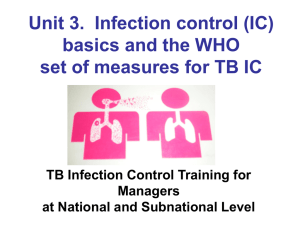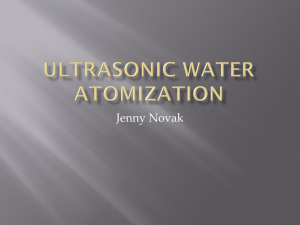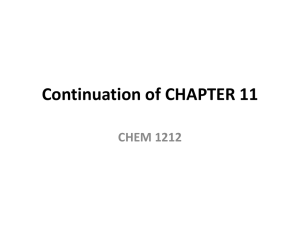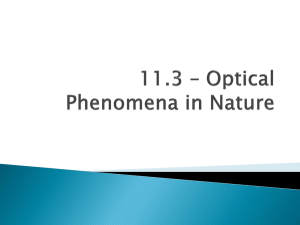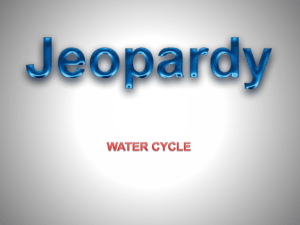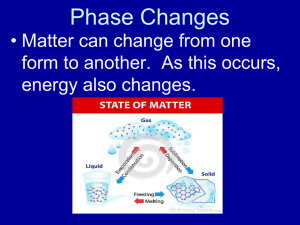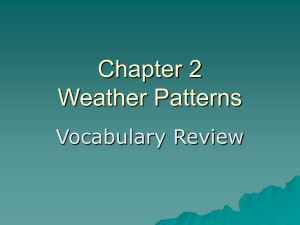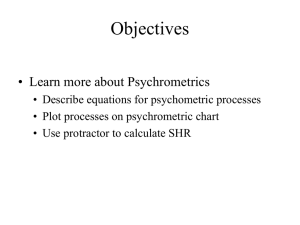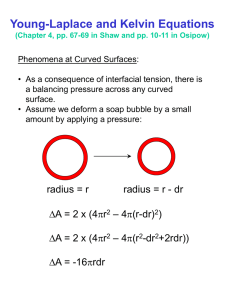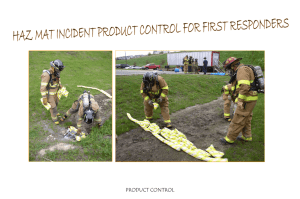Lecture 22, Droplet Growth
advertisement
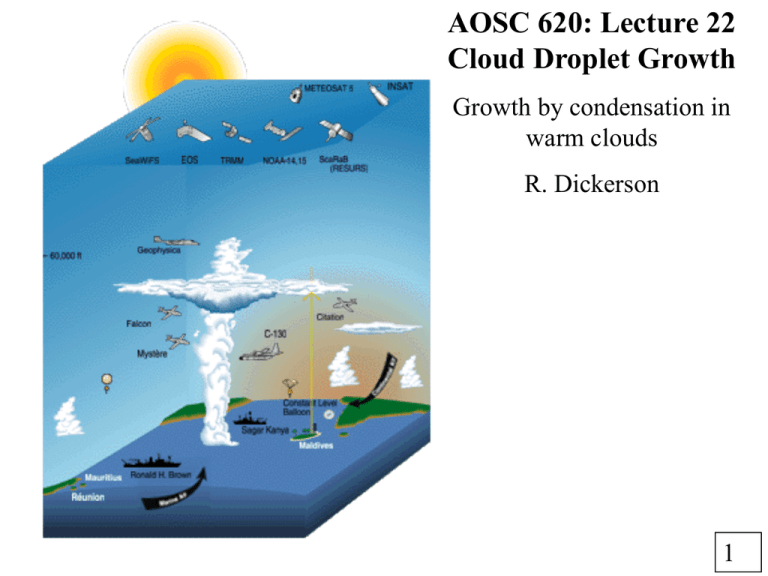
AOSC 620: Lecture 22
Cloud Droplet Growth
Growth by condensation in
warm clouds
R. Dickerson
North Dakota Thunderstorm Experiment
1
Kelvin Curve
Köhler Curve
2
Koehler Curve Plus.
Impact of 1 ppb HNO3
vapor (curve 3). PSC’s
often form in HNO3/H2O
mixtures. From Finlayson
and Pitts, page 803.
3
CCN spectra
from Hudson and
Yum (JGR 2002)
and in Wallace and
Hobbs (Yun is a
spelling error) page
214.
4
CCN measured in the marine boundary layer during
INDOEX. Hudson and Yum (JGR, 2002).
↓ITCZ
5
Growth of Individual Cloud Droplet
Depends upon
• Type and mass of hygroscopic nuclei.
• surface tension.
• humidity of the surrounding air.
• rate of transfer of water vapor to the droplet.
• rate of transfer of latent heat of condensation
away from the droplet.
6
Assumptions
• Isolated, spherical water droplet of mass M, radius r and
density w
• Droplet is growing by the diffusion of water vapor to the
surface.
• The temperature T and water vapor density v of the
remote environment remain constant.
• A steady state diffusion field is established around the
droplet so that the mass of water vapor diffusing across any
spherical surface of radius R centered on the droplet will be
independent of R and time t.
7
Fick’s Law of Diffusion
The flux of water vapor toward a droplet through
any spherical surface is given as
d v
Fw D v D
dR
where
D - diffusion coefficient of water vapor in air
v - density of water vapor
Note that Fw has units of mass/(unit area•unit time)
8
Mass Transport
Rate of mass transfer of water vapor toward the
drop through any radius R is denoted Tw (italics to
distinguish from R & Temp T) and
d v
dM
2
2
Tw
4 R Fw 4R D
A1
dt
dR
Note that Tw = A1(a constant) because we assumed
a steady state mass transfer.
9
Mass Transport - continued
Integrate the equation from the surface of the droplet
where the vapor density is vr to where it is v. How
far away is ? See below.
v
4D
dv A
vr
1
dR
R2
r
A1
4 D( v vr )
r
dM
but A1
dt
dM
4 r D( v vr )
dt
(1)
10
Conduction of Latent Heat
Assume that the latent heat released is dissipated
primarily by conduction to the surrounding air. Since
we assume that the mass growth is constant (A1), then
the latent heat transport is a constant (A2).
The equation for conduction of heat away from the
droplet may be written as
dM
dT
2
Lv
4 R K A2
dt
dR
K is the thermal conductivity of air
11
Conduction of Latent Heat - continued
Integrate the equation from the droplet surface to
several radii away which is effectively .
T
4 K
dT
Tr
A2
dR
R2
r
A2 Lv dM
r
r dt
dM 4rK
(Tr T )
dt
Lv
4 K (T Tr )
(2)
12
Radial Growth Equations
4 pr 3
Since M =
rw
3
dM
dr
2
= 4 p r rw
dt
dt
dr
D
r
=
(r v¥ - r vr )
dt
rw
dr
K
r
=
(Tr - T¥ )
dt
L v rw
(1a)
(2a)
13
14
Molecular diffusion to a droplet at 1.00 atm.
How far is infinity?
t = x2/D
x = 1.0 cm → t ≈ 4 s
x = 0.32 m → t ≈ 4,000 s
x = 1.0 m → t ≈ 40,000 s
Repeat at 0.10 atm.
The lifetime of a Cb is only a few hours.
15
Radial Growth - continued
Note that, the radius of a smaller droplet will increase faster
than a larger droplet.
vr
er
e
e
and v
RvTr
RvT
RvTr
or
dr
D
r
( e er )
dt w RvT
(1a )
dr
K
r
(Tr T )
dt Lv w
( 2a )
16
Important Variables
e
es
er
esr
Ambient water vapor pressure
Equilibrium (sat.) water vapor
pressure at ambient temperature
es = CC(T):
Equilibrium water vapor pressure for a
droplet
er: =ehr=CC(Tr) f(r)
a b
f(r) = (1 3 )
r r
Equilibrium water vapor pressure for
plane water at the same temperature as
the droplet
esr= CC(Tr):
17
Additional Equations
• Clausius-Clapeyron equation
• Combined curvature and solute effects
Integrate the CC equation from the saturation
vapor pressure at the temperature of the
environment es(T), denoted as es , to the
saturation vapor pressure at the droplet surface
es(Tr), denoted esr to obtain
esr Lv
ln
es Rv
( ) ( )
1 1
–
T Tr
Lv
Tr – T
2
RvT
18
Final Set of Growth Equations
• Mass diffusion to the droplet
dr
D
r
=
(e ¥ - e r )
dt
rw R v T¥
dr
K
=
(Tr - T¥ )
• Conduction of latent heat away r
dt
L v rw
• Combined curvature and solute effects
• Clausius-Clapeyron equation
(1a)
(2a)
er
a b
1 3
esr
r r
esr
exp
es
{ ( )}
Lv
Tr – T
2
RvT
19
Summary
The four equations are a set of simultaneous equations for
er, esr , Tr , and r.
If we know the vapor pressure and temperature of the
environment and the mass of solute, the four unknowns
may be calculated for any value of r. Then, r may be
calculated by numerical integration.
20
Derivation of Droplet Radius
Dependence on Time
Steps to solve the Problem
• Expand Clausius-Clapeyron Equation
• Substitute for Tr - T in (2) using the expansion
• Express the ratio (esr/es in terms of radial
growth rate from (1)
• Solve resulting equation for r (dr/dt)
21
Derivation
Define S , the saturationratio of the environment , as
e
S
es
Eq.1 m aybe rewriten as
Des
dr
D
er
r
( S es er )
(S
)
dt w RvT
w RvT
es
Note that
er esr er
es es es r
22
Derivation - continued
Solving for (esr /es) one obtains
es r
es
¥
æe öæ
r w R v T¥ dr ö
sr
÷ çS = ç
r ÷
ç e ÷ç
De
dt ÷
è r øè
ø
s¥
But from the Clausius-Clapeyron equation
es r
es ¥
» 1 +
Lv
2 (Tr - T¥ )
R v T¥
because the argument of the exponent <<1 for
most problems of interest
23
Derivation - continued
But, from Eq. (2) we can write
Lv w dr
(Tr T )
r
K
dt
Com biningwith the Clausius ClapeyronEq. yields
esr
L2v w dr
1
r
2
es
Rv KT dt
24
Derivation - continued
Note that some quantities always appear together.
Lets define:
C1 =
C2 =
L2v r w
R v KT¥2
r w R v T¥
Des¥
25
Derivation - continued
dr esr
dr
1 C1r S C2 r
dt er
dt
or
er
S
esr
dr
r
dt
er
C2 C1 e
sr
26
Derivation - continued
er
S
esr
dr
r
dt
er
C2 C1
esr
where
er
esr
a
b
= 1 +
- 3
r
r
27
Radius as a Function of Time
t - to =
ò
ro
r æ
ç C 2+ C 1er
ç
sr
e
è
æ
er ö
çS ÷
esr ø
è
ö
÷
÷
ø
rdr
Note that, in general, this requires a numerical integration
28
Analytic Approximation
Since (er /esr ) 1 after nucleation
Consider the case where S, C1, and C2 are constant. Separate
variables and integrate as:
r 2 - ro2
(S - 1)
=
(t - t o )
2
(C1 + C 2 )
or
æ 2
ö
2(S - 1)
ç
r(t) = ro +
(t - t o )÷
è
(C1 + C2 )
ø
1
2
29
30
Lifetime of a Cb ~ 1 hr. Why are cloud droplets fairly uniform in size?
31
ξ1 is normalized growth parameter where ξ = (S-1)/(Fk + Fd).
At 790 hPa and 10C, ξ1 102 = 100 mm2 s-1. Growth rates converge after ~20 mm. 32
33
Summary for Cloud Droplet Growth by Condensation
1. Condensation depends on a seed or CCN.
2. Initial growth is a balance between the surface tension
and energy of condensation.
3. Rate of growth depends on rate of vapor transfer and rate
of latent heat dissipation.
4. Droplets formed on large CCN grow faster, but only at
first.
5. Droplet growth slows after r ~ 20 mm.
6. Diffusion is a near field (cm’s) phenomenon.
7. Cloud droplets that fall out of a cloud evaporate before
they hit the ground.
8. Why is there ever rain?
34

